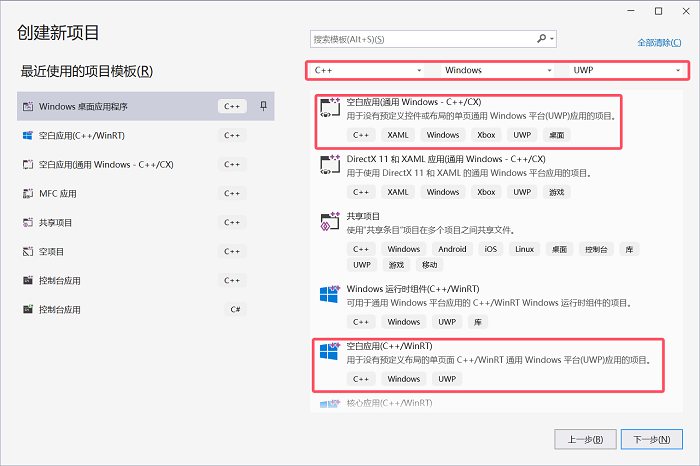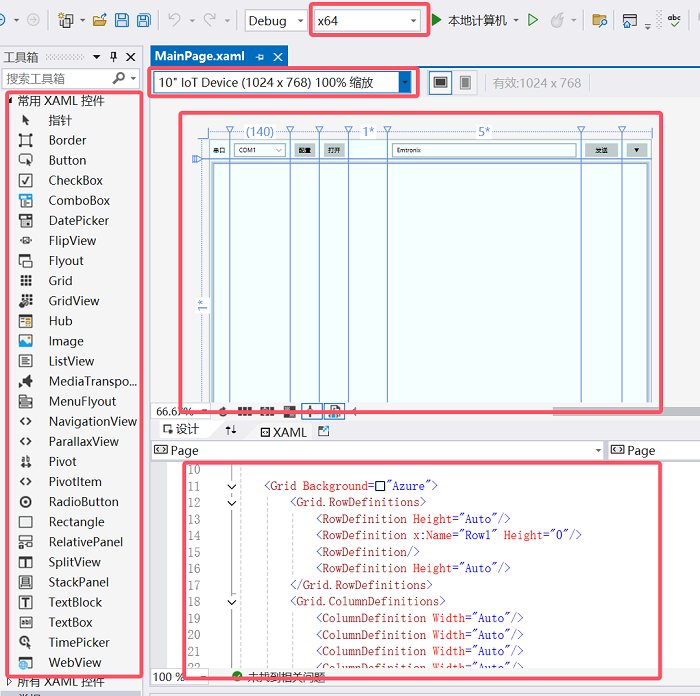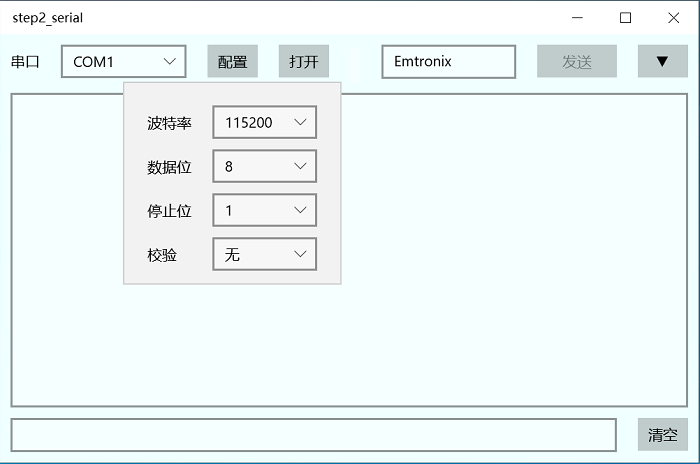Windows 10 ARM64平台UWP串口程序
Windows 10 IoT ARM64平台支持最新的UWP框架,本文将介绍如何开发一个UWP基础串口程序。
1、创建UWP工程
1. 打开visual studio 2022,点击“创建新项目”。
2. 选择筛选条件,语言C++或C#或VB(它们框架结构一样,库名及使用方法一样,只是不同语言写法不一样,本文以C++为例)。平台选择Windows,应用类型选择UWP。
3. 选择“空白应用”,其中后面括号标注(C++/CX)表示C++ 14规范,括号标注(C++/WinRT)表示C++ 17规范,它们语法特性有所不同,用户可选择自己更熟悉的标准创建项目(本文以C++/CX为例)。

2、UWP界面设计
1. 创建工程后,双击解决方案资源管理器中MainPage.xaml文件进入界面编辑,先选择平台为X64,选择好工程所适应的屏幕大小。

2. UWP通过XAML语言进行界面设计,可以直接拖动控件到设计窗口中,再编辑控件的属性,即可在XAML代码页里看到自动生成的界面代码。也可以直接在XAML代码页中编辑。
3. 这里我们在Grid中创建4*8的表格,然后将控件放入相应的表格单元中,使得控件更加整齐,也便于窗口大小变化时控制自动对齐,更美观。
4. 设置好各个控件的控件名称,Margin,及事件绑定函数等。弹出子窗口可以用Flyout实现。
<Grid Background="Azure"> <Grid.RowDefinitions> <RowDefinition Height="Auto"/> <RowDefinition x:Name="Row1" Height="0"/> <RowDefinition/> <RowDefinition Height="Auto"/> </Grid.RowDefinitions> <Grid.ColumnDefinitions> <ColumnDefinition Width="Auto"/> <ColumnDefinition Width="Auto"/> <ColumnDefinition Width="Auto"/> <ColumnDefinition Width="Auto"/> <ColumnDefinition Width="*"/> <ColumnDefinition Width="5*"/> <ColumnDefinition Width="Auto"/> <ColumnDefinition Width="Auto"/> </Grid.ColumnDefinitions> <TextBlock Text="串口" Margin="10,16,10,0" VerticalAlignment="Top"/> <ComboBox x:Name="ComboPort" Grid.Column="1" Margin="10,10,10,0" VerticalAlignment="Top" SelectedIndex="0" Width="120"> <ComboBoxItem Content="COM1"/> <ComboBoxItem Content="COM2"/> <ComboBoxItem Content="COM3"/> </ComboBox> <Button x:Name="BtnCfg" Content="配置" Grid.Column="2" Margin="10,10,10,0" HorizontalAlignment="Stretch" VerticalAlignment="Top"> <Button.Flyout> <Flyout> <Grid> <Grid.RowDefinitions> <RowDefinition Height="Auto"/> <RowDefinition Height="Auto"/> <RowDefinition Height="Auto"/> <RowDefinition/> </Grid.RowDefinitions> <Grid.ColumnDefinitions> <ColumnDefinition Width="Auto"/> <ColumnDefinition/> </Grid.ColumnDefinitions> <TextBlock Text="波特率" Margin="10,10,10,0" VerticalAlignment="Center"/> <ComboBox x:Name="ComboBaud" Grid.Column="1" Margin="10,10,10,0" VerticalAlignment="Stretch" SelectedIndex="5" Width="100"> <ComboBoxItem Content="4800"/> <ComboBoxItem Content="9600"/> <ComboBoxItem Content="19200"/> <ComboBoxItem Content="38400"/> <ComboBoxItem Content="57600"/> <ComboBoxItem Content="115200"/> <ComboBoxItem Content="230400"/> <ComboBoxItem Content="460800"/> <ComboBoxItem Content="921600"/> </ComboBox> <TextBlock Text="数据位" Grid.Row="1" Margin="10,10,10,0" VerticalAlignment="Center"/> <ComboBox x:Name="ComboDataBit" Grid.Row="1" Grid.Column="1" Margin="10,10,10,0" VerticalAlignment="Stretch" SelectedIndex="1" Width="100"> <ComboBoxItem Content="7"/> <ComboBoxItem Content="8"/> </ComboBox> <TextBlock Text="停止位" Grid.Row="2" Margin="10,10,10,0" VerticalAlignment="Center"/> <ComboBox x:Name="ComboStopBit" Grid.Row="2" Grid.Column="1" Margin="10,10,10,0" VerticalAlignment="Stretch" SelectedIndex="0" Width="100"> <ComboBoxItem Content="1"/> <ComboBoxItem Content="1.5"/> <ComboBoxItem Content="2"/> </ComboBox> <TextBlock Text="校验" Grid.Row="3" Margin="10,10,10,0" VerticalAlignment="Center"/> <ComboBox x:Name="ComboParity" Grid.Row="3" Grid.Column="1" Margin="10,10,10,0" VerticalAlignment="Stretch" SelectedIndex="0" Width="100"> <ComboBoxItem Content="无"/> <ComboBoxItem Content="奇"/> <ComboBoxItem Content="偶"/> </ComboBox> </Grid> </Flyout> </Button.Flyout> </Button> <Button x:Name="BtnOpen" Content="打开" Grid.Column="3" Margin="10,10,10,0" HorizontalAlignment="Stretch" VerticalAlignment="Top" Click="BtnOpen_Click"/> <TextBox x:Name="TBoxInfo" Grid.Column="4" Margin="10,14,10,0" BorderThickness="0" HorizontalAlignment="Stretch" VerticalAlignment="Top" IsReadOnly="True" Foreground="Red"/> <TextBox x:Name="TBoxSend" Grid.Column="5" Margin="10,10,10,0" HorizontalAlignment="Stretch" VerticalAlignment="Top" Text="Emtronix" TextWrapping="Wrap" AcceptsReturn="True"/> <Button x:Name="BtnSend" Content="发送" Grid.Column="6" Margin="10,10,10,0" HorizontalAlignment="Stretch" Click="BtnSend_Click" VerticalAlignment="Top"/> <Button x:Name="BtnMore" Content="▼" Width="48" Grid.Column="7" Margin="10,10,10,0" HorizontalAlignment="Right" VerticalAlignment="Top" Click="BtnMore_Click"/> <TextBlock Text="间隔" Grid.Row="1" Grid.Column="5" Margin="10,10,120,0" VerticalAlignment="Center" HorizontalAlignment="Right"/> <ComboBox x:Name="ComboTimer" Grid.Row="1" Grid.Column="5" Margin="10,10,10,0" Width="100" SelectedIndex="0" VerticalAlignment="Top" HorizontalAlignment="Right"> <ComboBoxItem Content="10ms"/> <ComboBoxItem Content="20ms"/> <ComboBoxItem Content="50ms"/> <ComboBoxItem Content="100ms"/> <ComboBoxItem Content="200ms"/> <ComboBoxItem Content="500ms"/> <ComboBoxItem Content="1s"/> <ComboBoxItem Content="2s"/> </ComboBox> <Button x:Name="BtnAuto" Content="自动发送" Grid.Row="1" Grid.Column="6" Margin="10,10,10,0" HorizontalAlignment="Stretch" VerticalAlignment="Top" Click="BtnAuto_Click"/> <TextBox x:Name="TBoxRecv" Grid.Row="2" Grid.ColumnSpan="8" Margin="10" HorizontalAlignment="Stretch" TextWrapping="Wrap" IsReadOnly="True" ScrollViewer.VerticalScrollMode="Auto"/> <TextBox x:Name="TBoxState" Grid.Row="3" Grid.ColumnSpan="7" Margin="10,0,10,10" HorizontalAlignment="Stretch" IsReadOnly="True"/> <Button x:Name="BtnClean" Content="清空" Grid.Row="3" Grid.Column="8" Margin="10,0,10,10" HorizontalAlignment="Stretch" VerticalAlignment="Top" Click="BtnClean_Click"/> </Grid>
3、串口代码设计
用记事本打开工程Package.appxmanifest,在Capabilities里添加如下内容
<Capabilities> <Capability Name="internetClient" /> <DeviceCapability Name="serialcommunication"> <Device Id="any"> <Function Type="name:serialPort" /> </Device> </DeviceCapability> </Capabilities>
3.1 查询串口
已知串口名,可以直接通过CreateFile打开串口。否则需要查询设备中的串口。
除了可以用API函数CM_Get_Device_Interface_List查询,微软专门封装了一个硬件库Devices,可以更简便地访问设备接口。
通过任务方式create_task查询接口,可以避免主界面卡顿,使用任务比使用线程更简便些。
通过创建cancellationToken,可以根据需求随时中断任务。
使用then可以链式执行任务,相比使用函数,代码逻辑可读性更高些。
Platform::Collections::Vector<Platform::Object^>^ _serialDevice;
MainPage::MainPage()
{
InitializeComponent();
//…
_serialDevice = ref new Platform::Collections::Vector<Platform::Object^>();
ListAllPorts();
}
void MainPage::ListAllPorts(void)
{
cancellationTokenSource = new Concurrency::cancellation_token_source();
Concurrency::create_task(FindAllAsyncSerialAsync()).then([this](Windows::Devices::Enumeration::DeviceInformationCollection^ devices)
{
_serialDevice->Clear();
Windows::Devices::Enumeration::DeviceInformation^ deviceInfo;
for (auto&& deviceInfo : devices)
{
_serialDevice->Append(ref new Device(deviceInfo->Id, deviceInfo));
}
});
}
Windows::Foundation::IAsyncOperation<Windows::Devices::Enumeration::DeviceInformationCollection^>^ MainPage::FindAllAsyncSerialAsync(void)
{
String^ aqs = Windows::Devices::SerialCommunication::SerialDevice::GetDeviceSelector();
return Windows::Devices::Enumeration::DeviceInformation::FindAllAsync(aqs);
}3.2 打开串口
使用Devices库的串口方法异步打开串口,设置串口各个参数。
void MainPage::OpenPort()
{
int index = ComboPort->SelectedIndex;
Device^ device = static_cast<Device^>(_serialDevice->GetAt(index));
Windows::Devices::Enumeration::DeviceInformation^ entry = device->DeviceInfo;
concurrency::create_task(OpenPortAsync(entry, cancellationTokenSource->get_token()));
return;
}
Concurrency::task<void> MainPage::OpenPortAsync(Windows::Devices::Enumeration::DeviceInformation^ device, Concurrency::cancellation_token cancellationToken)
{
auto childTokenSource = Concurrency::cancellation_token_source::create_linked_source(cancellationToken);
auto childToken = childTokenSource.get_token();
return Concurrency::create_task(Windows::Devices::SerialCommunication::SerialDevice::FromIdAsync(device->Id), childToken)
.then([this](Windows::Devices::SerialCommunication::SerialDevice^ serial_device)
{
try
{
_serialPort = serial_device;
Windows::Foundation::TimeSpan _timeOut;
_timeOut.Duration = 100L;
// Configure serial settings
_serialPort->WriteTimeout = _timeOut;
_serialPort->ReadTimeout = _timeOut;
serialPort->DataBits = 115200;
_serialPort->DataBits = 7;
_serialPort->StopBits = Windows::Devices::SerialCommunication::SerialStopBitCount::One;
_serialPort->Parity = Windows::Devices::SerialCommunication::SerialParity::None;
_serialPort->Handshake = Windows::Devices::SerialCommunication::SerialHandshake::None;
_dataReaderObject = ref new Windows::Storage::Streams::DataReader(_serialPort->InputStream);
_dataReaderObject->InputStreamOptions = Windows::Storage::Streams::InputStreamOptions::Partial;
_dataWriterObject = ref new Windows::Storage::Streams::DataWriter(_serialPort->OutputStream);
Listen();
}
catch (Platform::Exception^ ex)
{
}
});
}绑定串口输入输出流到自定的Object中,以便后面任务通过Object读写串口。
开启任务读串口信息。
3.3 读串口
创建listen函数用于串口数据读取。
Listen函数中创建读取串口任务。使用任务或线程都可以实现代码的并发运行,具体使用任务还是使用线程,用户可以根据应用实际情况选择,一般来说任务相对简洁,适合短操作,线程更适合长时运行的操作。本文采用任务模式实现串口数据监听,读取。
void MainPage::Listen()
{
try
{
if (_serialPort != nullptr)
{
concurrency::create_task(ReadAsync(cancellationTokenSource->get_token()));
}
}
catch (Platform::Exception^ ex)
{
if (ex->GetType()->FullName == "TaskCanceledException")
{
ClosePort();
}
}
}读取成功后,继续listen监听下一段串口信息。
Concurrency::task<void> MainPage::ReadAsync(Concurrency::cancellation_token cancellationToken)
{
unsigned int _readBufferLength = 1024;
auto childTokenSource = Concurrency::cancellation_token_source::create_linked_source(cancellationToken);
auto childToken = childTokenSource.get_token();
return concurrency::create_task(_dataReaderObject->LoadAsync(_readBufferLength), childToken).then([this](unsigned int bytesRead)
{
if (bytesRead > 0)
{
m_Rx += bytesRead;
TBoxRecv->Text += _dataReaderObject->ReadString(bytesRead);
ShowState();
}
Listen();
});
}如果串口关闭,通过Token立刻关闭可能正在执行中的读取任务。
void MainPage::CancelReadTask(void)
{
cancellationTokenSource->cancel();
}3.4 写串口
当点击发送按钮时,创建任务进行串口写数据
void step2_serial::MainPage::BtnSend_Click(Platform::Object^ sender, Windows::UI::Xaml::RoutedEventArgs^ e)
{
if (_serialPort != nullptr)
{
try
{
WriteAsync(cancellationTokenSource->get_token());
}
catch (Platform::Exception^ ex)
{
}
}
}
Concurrency::task<void> MainPage::WriteAsync(Concurrency::cancellation_token cancellationToken)
{
_dataWriterObject->WriteString(TBoxSend->Text);
auto childTokenSource = Concurrency::cancellation_token_source::create_linked_source(cancellationToken);
auto childToken = childTokenSource.get_token();
return concurrency::create_task(_dataWriterObject->StoreAsync(), childToken).then([this](unsigned int bytesWritten)
{
if (bytesWritten > 0)
{
m_Tx += bytesWritten;
}
});
}如果串口关闭,通过Token立刻关闭可能正在执行中的写任务。
3.5 串口关闭
当点击关闭按钮,或其它原因中断串口读写时
void MainPage::ClosePort()
{
delete(_dataReaderObject);
_dataReaderObject = nullptr;
delete(_dataWriterObject);
_dataWriterObject = nullptr;
delete(_serialPort);
_serialPort = nullptr;
return;
}通过Token通知立刻关闭任务,关闭打开的串口读写Object
CancelReadTask();
3.6 创建timer用于自动发送
可以添加一个自动发送功能方便测试,UWP中添加timer的方式如下。
Windows::UI::Xaml::DispatcherTimer^ m_Timer;
m_Timer = ref new Windows::UI::Xaml::DispatcherTimer();
TimeSpan ts;
ts.Duration = 20*10000; //表示20ms
m_Timer->Interval = ts;
m_Timer->Tick += ref new EventHandler<Object^>(this, &MainPage::AutoTimer_Tick); //m_Timer->Start();
void step2_serial::MainPage::AutoTimer_Tick(Object^ sender, Object^ e)
{
if (_serialPort != nullptr)
{
try
{
if (TBoxSend->Text->Length() > 0)
{
WriteAsync(cancellationTokenSource->get_token());
}
}
catch (Platform::Exception^ ex)
{
}
}
}4、调试
打开Win10 IoT板子上的调试助手。

选择工程平台为ARM64,编译运行,示例如下。

需要程序源码可以联系英创工程师获得。